|
|
|
I am often asked the question, “what makes a great photograph?” I always answer the question the same way – “composition.” However, my view of composition is not the same as the standard text book definition of the word. Composing an image is not just about how you arrange the elements of your scene. It goes much deeper than that. To achieve a great composition, one must consider each of the following:
- What is your subject matter?
- What is the quality of light on your scene? Would it be better under different lighting conditions?
- What lens are you going to use to capture your scene?
- How are you going to use your exposure to add artistic quality to the image?
- What elements of your scene are important to you, and how are you going to arrange them within your image?
All of these questions must be answered in order to successfully compose an image, and all of these questions are directly related to composition. Let's take a look at each of these questions again in more detail.
Subject Matter
This is quite possibly the most important decision you're going to make when creating a nature photograph. Does the scene inspire and touch you emotionally enough to make you want to take a photograph? If the answer is yes, then the potential probably exists to create a great image. All too often, we take photographs of places just to document what we saw and experienced. It's the times and places that touch us emotionally that make truly great images. Seek out these locations, and spend extra time to ensure you capture the scene in the most inspiring and dynamic way possible. You'll be amazed at how many more "keepers" you will get when you start to follow your emotions instead of just your eyes.
Light
Light is another critically important element in a photograph. I'm a firm believer that there is no such thing as bad light, only bad light for a particular scene. I have captured great images at all hours of the day. However, certain scenes lend themselves better to different types of light. Most often, grand landscapes are best captured in the early mornings and late afternoons. The light on the land and clouds take on that warm glow from the rising or setting sun, and the shadows are long and deep giving a three dimensional appearance to your images. Midday, you’re best off shooting tighter more intimate scenes in the shaded valleys and canyons. Overcast days are great for photographing fall colors and stream shots pretty much all day long. Stormy days can offer up a dramatic shot at almost any time.
Try and get in the habit of asking yourself if the light on your scene is the best that it can be, or would it be better under different conditions. Shooting under the right lighting conditions will drastically improve the quality of the images you capture.
Lens Choice
Understanding how different focal length lenses capture a scene is essential when taking landscape photographs. Not all lenses render a scene the same way. Understanding the differences will open up a whole new set of compositional techniques for you the next time you're in the field. Let's take a look at the two most common types of lenses and how they affect your image.
Wide angle lenses (14mm to 35mm) can be quite difficult to use at first, until you understand what they are doing to your scene. Wide angle lenses can see a much larger and wider area than the human eye can see. This alone, often makes an image look kind of odd. They also make distant objects seem much smaller and further away than they actually are. So why would you want to use one? Quite simple - they are capable of capturing a tremendous amount of near / far focus (depth of field), and when used properly can create some very dynamic compositions. Try using your wide angle lens when you want to emphasize the foreground in your shot against a wide and sweeping landscape. They are also great for more intimate shots where your foreground is the main subject of your image. Angling your camera down slightly will add a dramatic depth to your image. Experimentation is key here. The image of the moss covered rock below is a good example of how to use a wide angle lens.
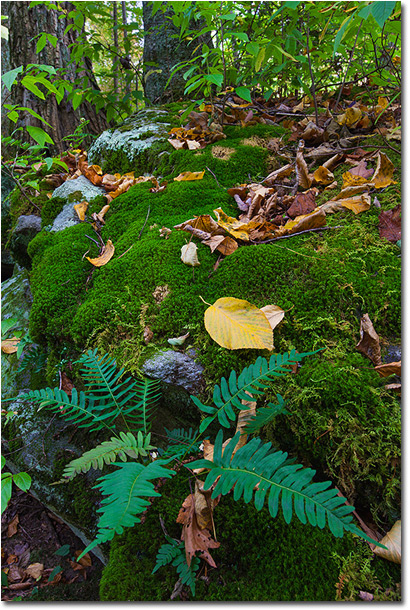
Telephoto lenses do just the opposite. They pull your subject in closer, and make distant objects seem closer together than they actually are. This is why they are the lens of choice for wildlife photographers. However, they are quite useful for landscape photography too. The image of the cabin below was taken with a 400mm lens. The tree with the red leaves framing the image was almost 70 yards away from the cabin, however, the two seem like they are right next to each other. This is because of the compressing effect of the lens, making distant objects appear closer together than they actually are. Understanding this effect will open up a whole lot more compositional possibilities than you ever thought possible.
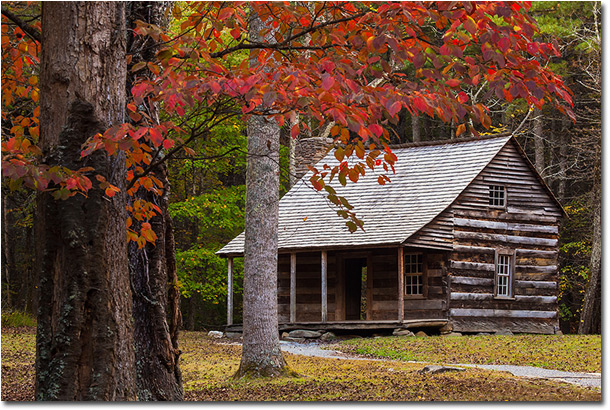
Exposure
One doesn't often think of exposure as a component of composition, however it is a very important artistic decision you make every time you take a photograph. Understanding how f-stops and shutter speeds affect your image is a huge step towards improving the artistic quality of your images. Let's take a look at each.
F-stops ultimately control how much depth of field (area of your image that is in focus) you have in your image. The larger the number (ex. f16, f22) the more depth of field you will have in your image. The smaller the number (ex. f2.8, f4) you will have less depth of field, and areas of your image will fall out of focus. Choosing the right f-stop is a critical decision you make when taking a nature photograph. It is also one that is directly related to your artistic composition. Choose a high number like f16 or f22 if you are taking a grand landscape image, and you want everything from your foreground to infinity to be in focus. Select a smaller number like f2.8 or f4 when taking close up photographs of flowers. This will allow the background to go out of focus creating a bokeh effect, which is isolating your subject against a soft out of focus background. This image of a Mexican Gold Poppy demonstrates this effect quite well.
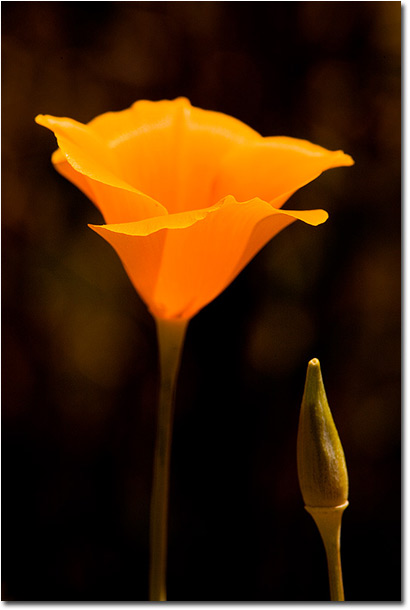
The discussion about f-stops can get quite technical. In fact, entire books have been written about nothing but the subject. This is just a brief overview of how your choice of f-stop will affect your image, and how to use it artistically in your compositions.
Shutter Speed
Your choice of shutter speed can also add artistic quality to your images when you understand what is happening to your image at different speeds. A fast shutter speed such as 1/250 sec or faster will freeze any motion within your image such as running water, leaves blowing in the wind, or an animal walking through your scene. A slow shutter speed of 1/30 sec or slower will allow any motion in your scene to blur in the final image. These effects can be used quite creatively in your compositions. A fast shutter speed used photographing waves crashing on a rocky shoreline will freeze the motion of the water, giving a feel of action and force. A slow shutter speed used while photographing a flowing stream will give you a peaceful, almost surreal feeling such as in the image below. The choice is yours. Be creative.
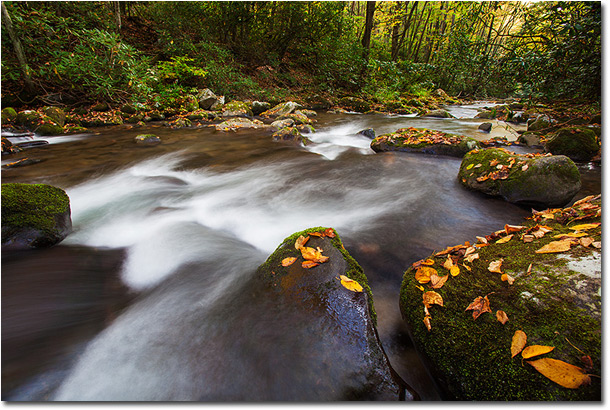
Composition
Finally we get to the text book definition of the word composition. How are you going to arrange all of the elements of your scene into the final image? I am a firm believer in keeping it simple in my compositions. Find a few key elements in your scene, and focus on arranging them artistically within your frame. Look for a strong foreground subject free of clutter, a good interesting mid ground such as mountains or a hill, and your sky. Now arrange these elements in your frame in a balanced and organized fashion. There are a number of ways of doing this such as the "rule of thirds", leading lines, and using geometric shapes such as triangles, circles, and s-curves. Do a quick internet search on compositional techniques, and study up on all the different methods of composing a scene. Once you learn all the different techniques, start using them in your images. However, don't feel like you are bound by these "rules". One of the biggest mistakes I see from beginning photographers is passing up an image just because they couldn't figure out how to make their scene fit the "rules" of composition. Not every image is going to work with the "rules". Use your imagination and creativity, and take the shot anyway. There was a reason you stopped to take the image in the first place. Take the shot. You'll be pleasantly surprised.
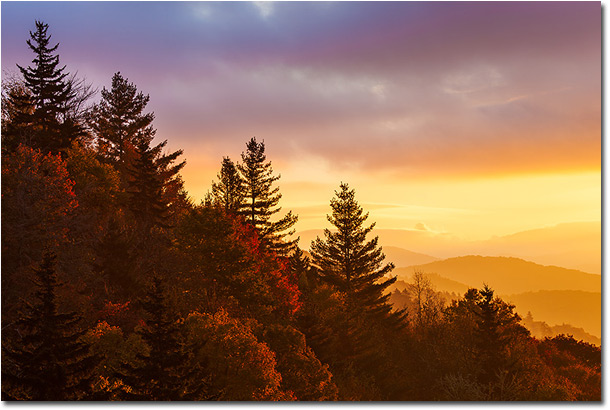
As you can see, composition covers a whole lot more than just how you are going frame all of the elements of your scene. It requires a lot more thought and planning. When you can get yourself to start considering all the factors outlined in this essay compositionally, the quality of your images will increase tenfold. It's a lot of work, and requires a lot of practice and study, but the final results are well worth the effort.
Jason Keefe - NPN 6308
|
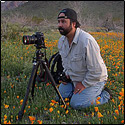 Jason Keefe is a Fine Art Landscape and Nature Photographer residing in the mountains of northwest Arizona. He has 20+ years experience in landscape photography, and has taught digital photography and Photoshop classes for his local community college.
Jason Keefe is a Fine Art Landscape and Nature Photographer residing in the mountains of northwest Arizona. He has 20+ years experience in landscape photography, and has taught digital photography and Photoshop classes for his local community college.
You can view more of Jason's work on his website at www.jasonkeefephotography.com.